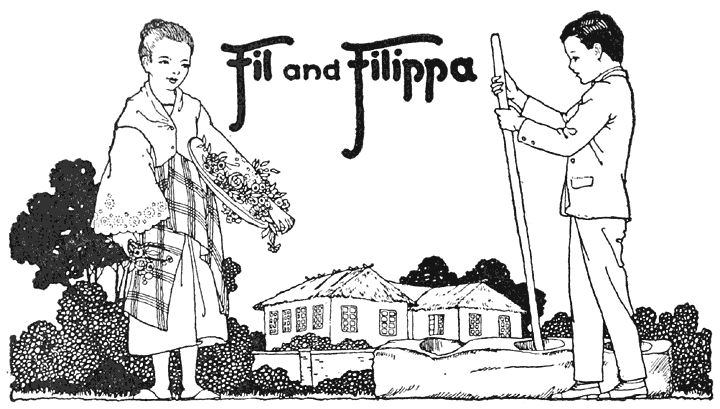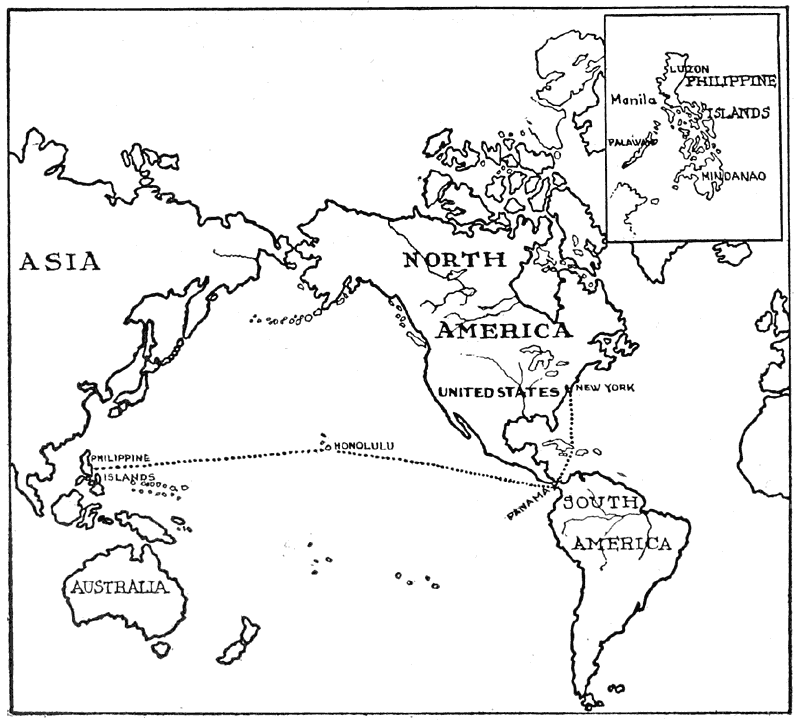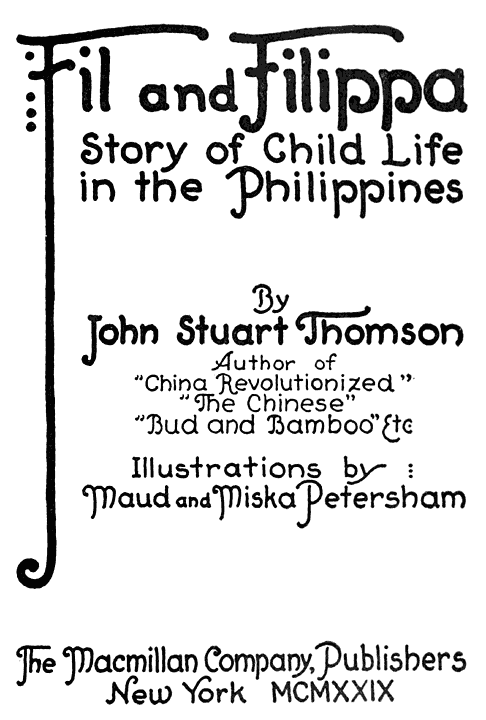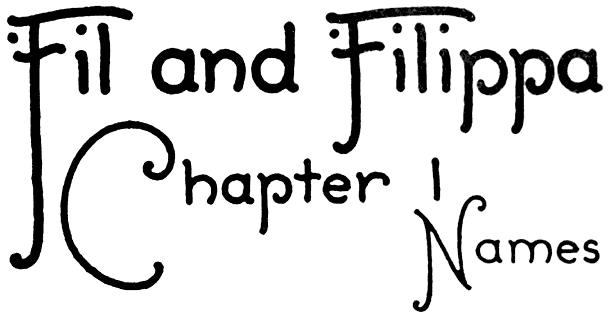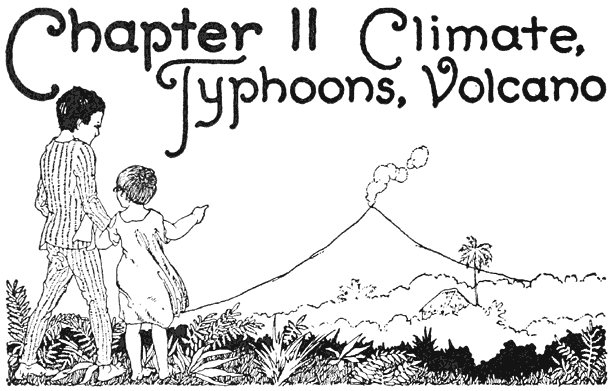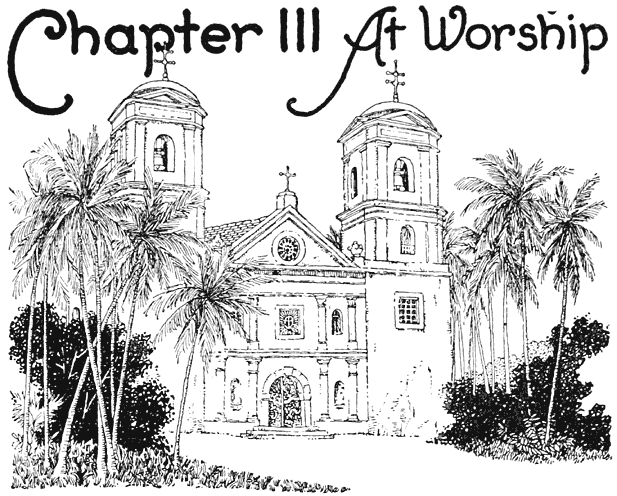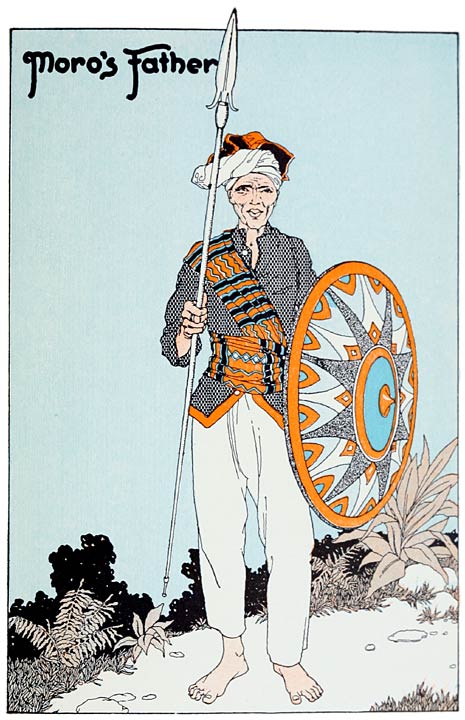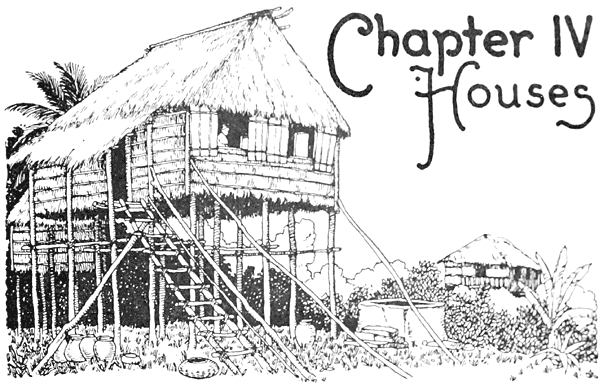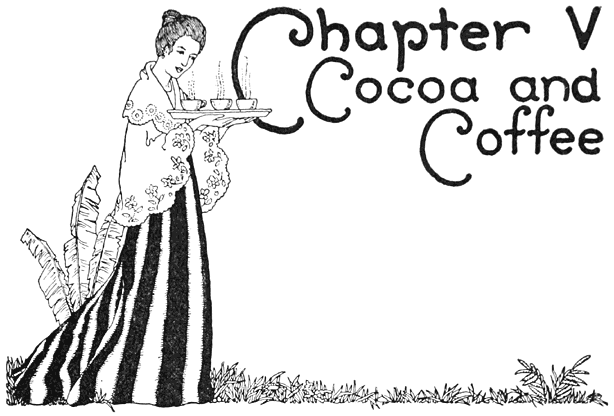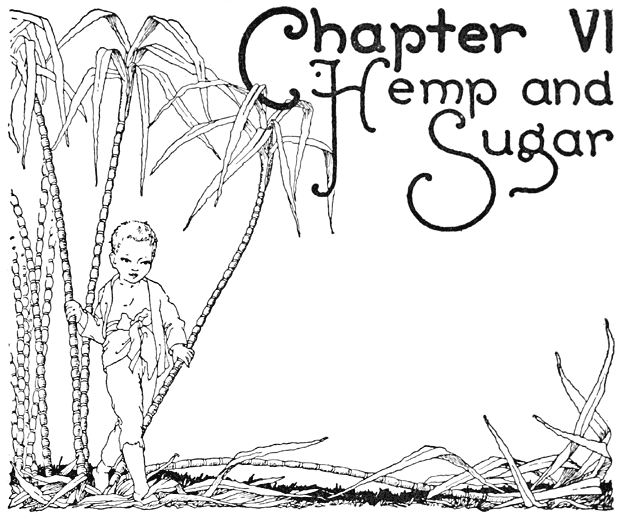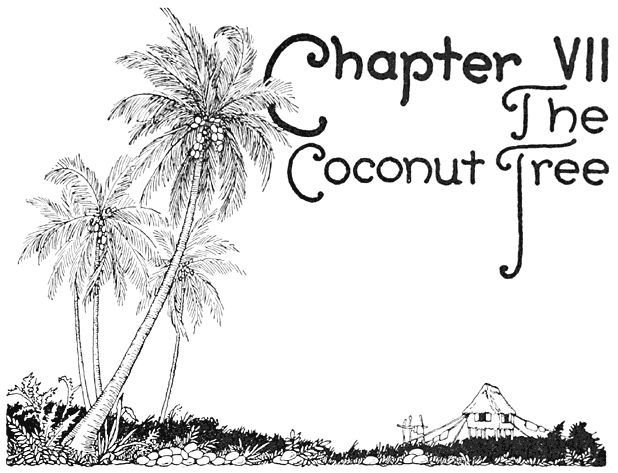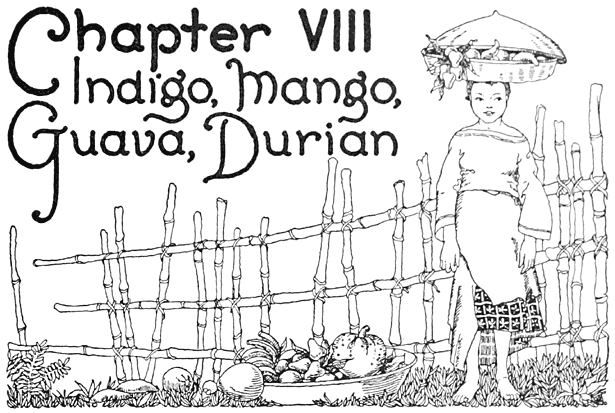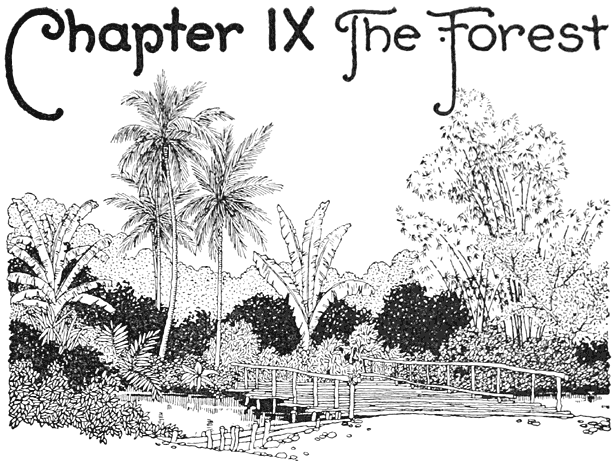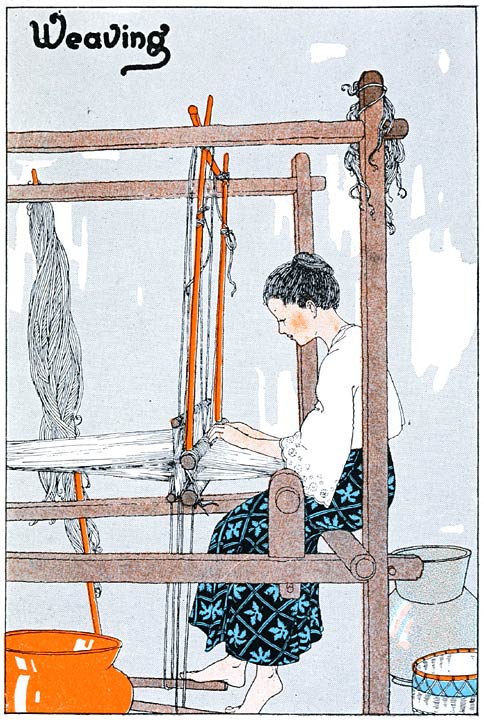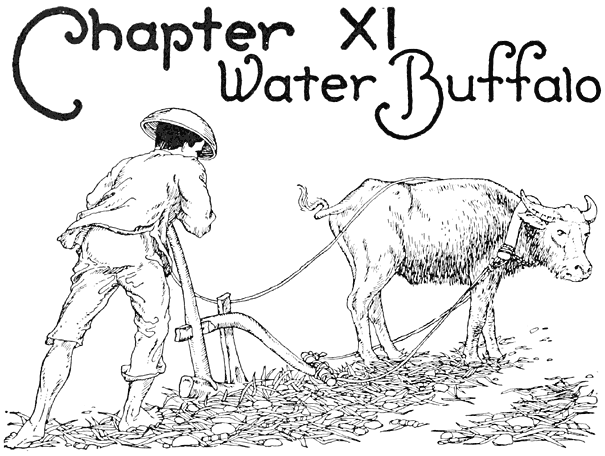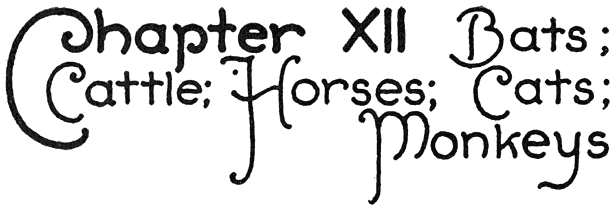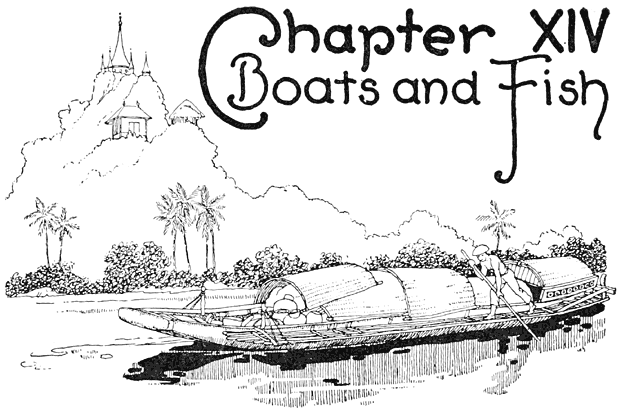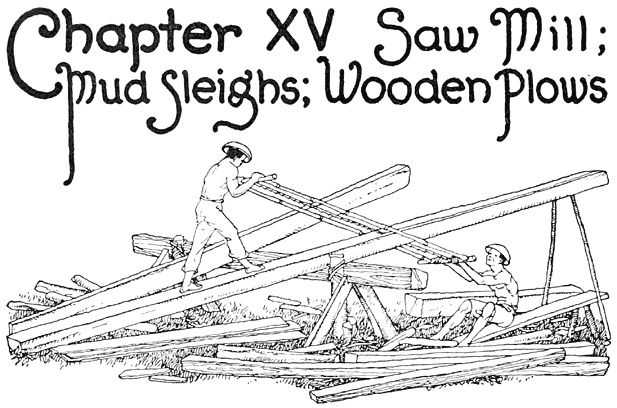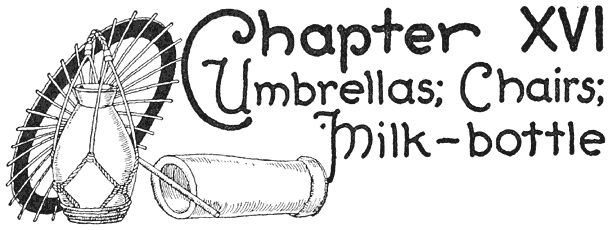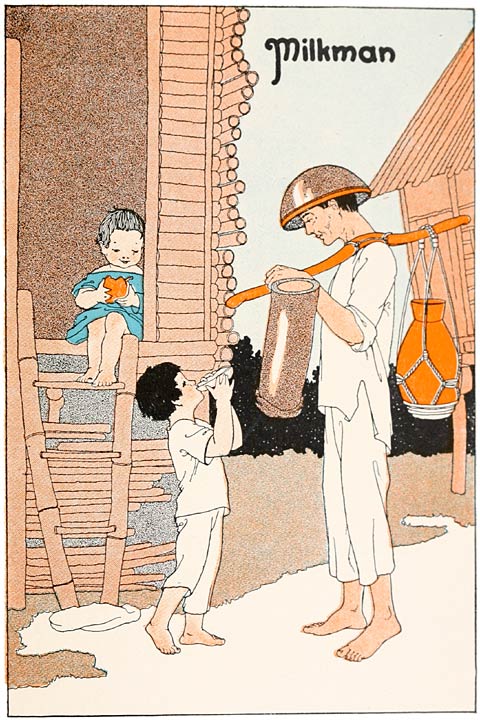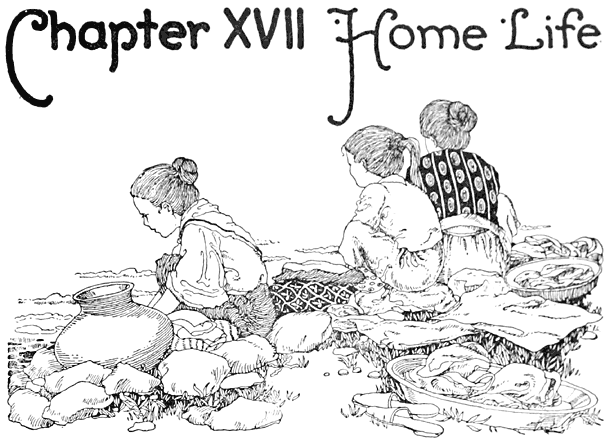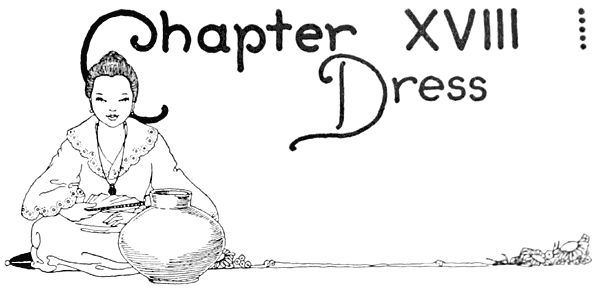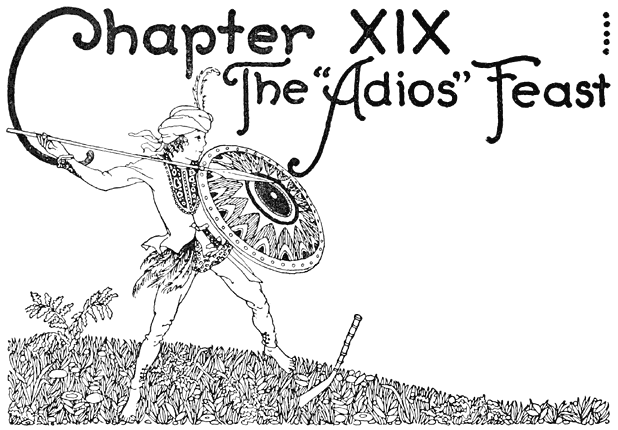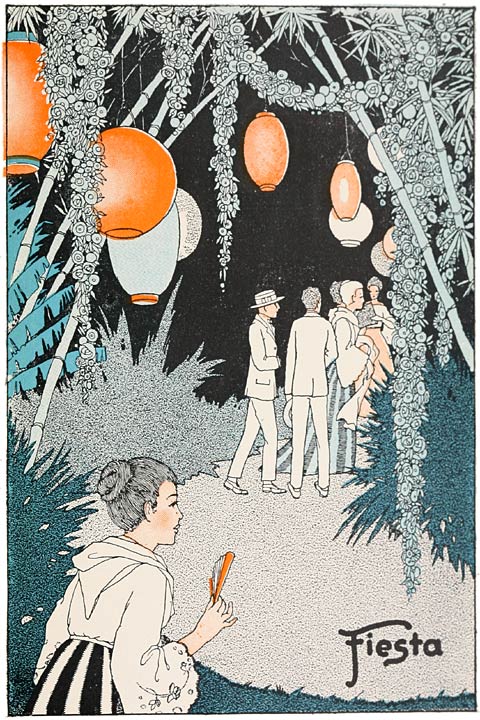[1]
[Contents]
Fil and Filippa
Chapter I
Names
It took me over a month and a half to reach the summer islands that I sought. In three weeks I had gone through the Panama
Canal and had reached San Francisco, and in four weeks more I had crossed the world’s widest, most peaceful, and bluest ocean,
the Pacific.
There, like a string of pearls hanging from the golden Equator, I found thousands of wonderful islands of all sizes, but only
two of them are very large. I found also my new and kind young friends: Fil; his sister Filippa; Fil’s boy playmate named
Moro, who came from the large southern island; their parents and friends; and the good Padre. Each one of them was shorter
and darker than I. Yet they said to me: “The Stars and Stripes, now our flag also, makes us all American brothers, which we
will be always.”
[2]
“But how is it that you are called Filipinos, and live in the Philippine Islands?” I asked.
Fil smiled and said: “Though I believe you know without asking me, I shall tell you to show that I know our romantic and interesting
history.
“Hundreds of years ago, many years before America became a nation, the roving Spaniards discovered these islands, and named
them the Philip-pines, in honor of their king Philip. When the American Admiral Dewey won these islands from Spain, our name
was not changed.
“And our Christian names of Fil and Filippa have the same sound, and almost the same meaning, as Philippines,” added Filippa,
her eyes smiling from under her cloud of beautiful hair,—hair longer and richer than an American girl’s hair,—and eyes darker
and deeper than an American girl’s eyes. Perhaps her brows were a little bit flatter, and her nose was a little bit shorter
and wider, than ours; but still she was pretty, especially when she smiled, for she had beautiful white teeth.
Then I turned to Fil’s playmate, Moro, and asked him what his rolling name could mean. Moro was even more eager and darker
than Fil. He replied, as he bravely touched his toy sword:
“I, too, am of the Malay race, but of a different religion from Fil. I am a Mohammedan; [3]that is, I reverence the same prophets whom the Turks worship. I come from the southern islands of the Philippines. There
we spend most of our time roving in boats, and hunting over the hills. The first white man who met us saw that we were as
dark, and had the same religion, as the tribes of Morocco in Africa. That perhaps is why I am called Moro, the Mohammedan,
whose father fears no man; nor shall I, when I grow up.”
“But we are all friends now under a new, friendly flag; and we preach and practice love, instead of fear and fighting,” I
replied.
Filippa looked upon me with very happy eyes, when I said this; for a girl seems to know wiser ways of settling quarrels than
do boys. A boy becomes excited; a girl thinks longer and acts more slowly. Certainly, Filippa’s gentle ways and the expression
in her wonderfully deep eyes had more power with Fil and Moro than would strife and force.
“Every name seems to have a pretty meaning in your Edenlike Philippines,” I remarked to Filippa’s playmate, Favra.
“Yes,” she replied, “the Padre (pă′drāi), our pastor or cleric, who knows so much, tells me that my name means the friendly
one who does favors.”
[4]
[Contents]
Chapter II
Climate, Typhoons, Volcano
Next day I met the Padre. He was seated on a cane chair under a clump of whispering bamboos, which are giant grasses as tall
and as strong as trees.
We had hardly exchanged morning greetings, by saying “Buenos dias (boo āi′nos dē′as),” before we heard the children running
along the white shell path, between the parklike tropical woods.
“Every one awakens early in this wonderful climate, yet no one seems to be fully awake,” I said.
The good Padre replied: “We are situated so near the Equator that the sun rises into full and bright daylight at once.”
[5]
“I seem to half dream all day. Is it the balmy warm air, or the scents of new flowers, or the equatorial sun?” I asked.
The Padre explained it by saying: “The sun throws more direct rays here; and they pierce through thin hats, and especially
through black clothes. It is best to wear thick, white paper helmets. Moreover, our climate is more damp than is America’s
climate.
“That is why you feel somewhat dreamy; and that is why everything in Nature, such as trees, fruits, flowers, ferns, and even
animals and birds, grow so richly; and why the flowers shed influences and perfumes on the air. It all appeals to the warmth,
color, and dreaminess in your happy imagination.
“You think of stories of Eden or Paradise perhaps, where one imagines no hard winter, no bare trees or lawns, no whiteness.
Everything is more beautiful to look upon here. The birds and winds and rains drop seeds; and at once lavish plants grow up.
You will soon become used to our warmer climate, because you will need to eat less meat and butter, which is the fuel that
keeps you warm. Instead you will eat more rice and fruit, which will give you strength, without heating you.”
At this moment, our little friend Moro pursed [6]out his cheek and made a sound like a howling siren or a storm.
“That noise reminds me of your awful typhoons. I passed through one of those whirling storms, just as I approached these islands
of beauty,” I exclaimed. “Can you explain that great wonder?” I asked.
“It is God, the Creator’s, magnificent but terrible act, such as you read about in the Book of Job or in the Psalms,” said
the Padre, who crossed himself and bowed in piety. The good children, except Moro, all made the holy sign.
Then the wise Padre continued: “Like great characters, for a long time gentle,—like peace which has covered the earth for
years,—so, in our still, summer seas, suddenly in September, everything seems to contradict and be in rebellion, with a force
unknown and unexpected before,—a force all the greater, because it was accumulating quietly for many months.
“The heat becomes unbearable. The winds arise and sweep all one way, for a time. Then comes the black rain. The heavy typhoon
soon begins to howl and to turn in a circle for two or three days. The wheeling storm moves from place to place, and finally
dies down at sea.”
Filippa inquired: “Why is such a circular storm of the Oriental tropics, called a typhoon?”
[7]
The Padre explained: “It is a word that we have taken from the Chinese, who live not many hours away from us, across the water
to the northwest. ‘Tai’ means great. ‘Fung’ or ‘phoon,’ means a wind. These storms sweep all the way from the Philippine Islands,
across the seas to China. We like the expressive word which the Chinese have given these wind storms.”
“We have another natural wonder here, the volcano,” said Favra.
“Yes,” replied the Padre, “the Taal (Tä′al) and Mayon (Mä y[+o]n′) volcanoes once were smoking and fiery mountains, shaped
like a cone. Years ago fire and lava, which is molten rock that has cooled, poured from their hot, pointed tops, ran down
the sides, and destroyed everything in their path.”
“What is lava?” asked Fil.
The Padre replied: “Even a volcano produces some good. This melted rock, when it becomes cold, forms a light, porous stone,
which is used for polishing. You use it in your bathroom, to rub ink off your hands. Lava stone is easily ground into powder.
When mixed with soap, this ground lava becomes a useful cleaning and polishing powder.”
“Nature is always useful, as well as grand [8]and beautiful,” remarked Fil’s father, who, dressed in a white silk suit and abacá hat, had just then come up the path.
“Where did you get that hat?” I laughingly asked Fil’s father.
“I’ll tell you some other time. It is made from reeds, woven under water to keep them damp and pliant. The hat, therefore,
is light, durable, and cool,” he replied.
[9]
[Contents]
Chapter III
At Worship
When I arose next day and walked to the usual morning seat under the bamboos, I found only Moro there.
“Where is everybody else?” I asked.
“At the Iglesia (ig lāi sē′a),” replied Moro.
I knew iglesia was the Philippine word for church; so I said to Moro: “Let us go there too, and see what they are all doing.”
After we had walked along the white shell paths, past the swaying fisher boats, over an ancient stone bridge, beneath tall
palms and hanging vines and thick bananas, we beheld a wonderfully carved doorway, with statues in the niches. Over the tree
tops, rose a noble [10]white dome. From the open windows, the sweet singing of sacred music came to our ears. It was the well-known Mass or communion
music of our own land, consisting of the beautiful strains of the Gloria, the Sanctus, and the Benedictus. As we came nearer,
the breeze wafted us sweet incense from the altar, sandal and spice and flower and cinnamon scents.
Though Moro was of a different faith, he took off his hat; so did I. The short Filipino men were dressed in white. The sweet-looking
Filipino women were dressed in wide-striped skirts, and white waists, with very large collars starched stiff. Over their heads
were large lace shawls called mantillas. They wore no hats, for they were very proud to show their fine long hair, filled
with gold and jeweled pins.
Every one dipped a finger in the water which was placed in a huge shell near the door. Then they bowed before the cross on
the altar, which was shining at the end of the long aisle.
In the front seats, under the high dome, we could see Filippa, her parents, and Favra. The colored light from the stained
glass windows fell down in rays and clouds of beauty upon the altar boys, who wore robes of purple and white lace.
[11]
The music of the blue and gold organ was subdued to a velvet whisper. Suddenly a boy arose behind the carved benches of the
choir. He sang in a voice as clear as a bird’s:
“Come, Holy Spirit, Come.”
It was Fil who was singing. The censers were swinging. The organ began to drown even Fil’s clear voice. Then all the singers
in the choir arose and filled the great dome, the long cathedral aisles, and even the palm grove outside the windows, with
a great burst of sacred music:
“Holy, Holy is the Lord.”
It was all very solemn and very sweet. Far richer than in the homeland, seemed the music, because of the greater natural beauty
of the tropics.
Then our good friend, the Padre, arose, and spoke to his people, about charity and missions and peace and the stranger within
the doors. He spoke so kindly that we all regretted war, and even hated the name of war. He asked us to give gifts for the
wounded and the poor in other sad, colder, harder lands of hate and evil.
Then he extended his hands. A great blessing [12]seemed to flow down from the pulpit and even from the walls of the holy temple of peace, where the white altar, the golden
cross, and the colored windows shone out as signs of purity and love.
When the service was dismissed, we all walked home together.
“When are you going to be a Christian, little Moro?” inquired the kind Padre.
“I am a Mohammedan. My people come from the southern Philippines. We worship one God, and Mohammed is his prophet. We make
converts by the sword of force, rather than by preaching,” replied Moro, his eyes looking strange and brave.
“Tell me more about your religion. I have heard it is peculiar,” said Filippa.
“When we pray, we face Mecca, instead of Jerusalem or Rome. At Mecca in Arabia is the Holy Book, which we call the Koran.
There, also, is the birthplace of Mohammed, our prophet. We believe in troops of angels above, as well as in ‘jinns,’ or spirits,
on earth, who are ready to help us. We have no altars in our mosques or churches.
“Our mosques are immense, plain structures, with only large Arabic letters of texts, painted on the walls and ceiling. Five
times a day, the [13]Muezzin priest mounts the outside of the mosque tower, and calls the faithful to prayer. Each Mohammedan carries his own praying
mat. After placing it on the tile floor beneath the thin pillars, he kneels and bows upon his mat, facing Mecca, where our
prophet was born. We do not use music or organs.”
All this Moro explained to us. What he told about his religion was very different, very interesting, very new.
“There are good things in your religion,” said the kind Padre, as he placed his hand gently on Moro’s dark head.
“You despise the use of intoxicating liquor. You teach the duty of giving alms and of being charitable to the poor, the unfortunate,
and the sick. You teach that every one is his brother’s keeper, and should help his brother to succeed in life. You teach
that cleanliness and plain living are almost a part of religion. And we Christians agree with you, Moro, in all these grand
ideas; for I think that, with all the sorrow now in the world, some of us have been too selfish, too luxurious, as though
we thought we would live forever, and had no duty except to ourselves.”
I, too, felt conscience-stricken for my homeland and for myself, when I heard, in this odd [14]and different quarter of our large world, the Filipino Padre’s true but kind moralizing over Moro’s different religion.
“The bells! Oh, the silver-sweet bells!” exclaimed Filippa’s mother.
“The bells of love and peace,” replied the Padre, as he glanced back at the twin towers of his white Iglesia (church) that
shone over the grove of coconut palms.
[15]
[Contents]
Chapter IV
Houses
“What odd homes! toy houses toppling over from their stilts!” I exclaimed, as we passed a remarkable village. All the buildings
were set up on poles, and had ladders for their dwellers to climb up to the high doors. The houses looked as though the lower
story had been washed away, and only the second story remained. Over each window and door projected a very neat eyebrow, so
to speak, either to shed rain or to keep out the sun.
“That is our famous nipa-thatch house used by the original Filipinos,” said Moro. “I can explain all about it, for all Moros,
and many backward tribes, use these houses.”
“Tell me everything,” I urged.
“First,” said Moro, “there is not one nail in a nipa-thatch house. Perched high in the [16]air on poles, as it is, you perhaps would think our typhoons would blow it over, just like a light bandbox.”
“So I would think,” I replied.
“Well,” laughed bright Moro, “let me ask you a question. What makes a pole snap before the rush of a storm? What makes a brick
wall give way before a sudden wind? And why does a tree or a reed bear the storm easily?”
“Because the tree and the reed are elastic enough to give a little,—to bend instead of breaking,” I answered.
“That is just it,” again laughed my little Master Moro. “Our small nipa hut, high in the air, sways a little, but rides out
the storm. Every pole, every beam, and every rafter of the frame, is all made of hollow bamboo. Bamboo is stronger than steel,
because it bends and gives, and then springs back. There is no nail in the house. Every crosspiece is tied with rattan, the
same vine with which you make cane chairs; so you know how strong and elastic it is.”
“And of what are the sloping roofs and the side walls made?” I inquired.
“Of the famous nipa palm,” Moro replied. “It grows in swamps, often near the sea. It looks [17]like a gigantic fern. Its wide leaves we lap one over another, and tie them to the bamboo frame by withes of tough cogon grass.”
“Are you not afraid of fire?” I asked.
Moro frankly said: “Yes, but as our house is so cheap, we can build a new one easily. However, in this warm climate we cook
in a separate house, and we bathe out of doors. We do not smoke within our nipa houses; it is too dangerous.”
“Tell our friend from across the purple ocean how we use the bamboo and the nipa plants, for other purposes besides building,”
remarked little Fil.
Moro continued: “From the sap of the nipa palm, we distill alcohol. From the hollow bamboo we make pipes for carrying water.
We boil the tender new shoots of bamboo, and eat them like celery. We put a stopper into one joint of a hollowed bamboo, and
use it for a bottle. The pliant bamboo root we make into whips. We make bridges, fences, window blinds, furniture, and carriages
out of bamboo. We even make blow guns and shoot our arrows at birds, through the bamboo stalk.”
“There are one hundred kinds of bamboo, and a thousand uses for the plant,” added Filippa.
[18]
“I should imagine that the bamboo is the skeleton or the framework, and that the nipa is the skin of the Philippine structure,”
I remarked.
“That is the doctor’s way of drawing a figure of speech,” laughed the Padre.
[19]
[Contents]
Chapter V
Cocoa and Coffee
The next morning Filippa’s mother refreshed us all with a cup of fragrant cocoa, so that we might begin the day in good spirits.
As I was sipping it, the Padre remarked in good humor:
“Did you Americans seize the Philippines merely for a cup of cocoa?”
I replied laughingly: “This cup of cocoa is so good, that I certainly would try to seize the Philippines for it.”
Filippa’s mother and father both bowed and said I was complimentary, like a diplomat.
Then I continued: “I am glad the Philippines are now ours, and yours too, because our money can help to develop the wonderful
tropical products which do not grow in our colder America. I wish you would explain [20]something about cocoa and coffee, which we prize very much and which we send our ships a long way to secure.”
Fil’s father, who was a planter of wide acres, replied:
“The cocoa bean and the coconut are two very different plants. Do not confuse them. The cocoa bean, out of which you grind
cocoa powder and chocolate for a drink, for bonbons, and for puddings, comes out of a fruit shaped like a large red cucumber.
This fruit grows on a tender bush, which must be shaded by a thick banana palm. In each fruit are twenty of these seeds, or
cocoa beans.
“They have hard skins, and are very bitter and stimulating. When eaten, they excite the heart, and thus make a person feel
active and alive. Soldiers and athletes eat them, to relieve fatigue. As soon as the fruit is gathered, the beans must be
dried in the sun, or be roasted. The cocoa bean is very oily. To make cocoa, the oil is extracted, when the beans are ground
into a paste. To make chocolate, the oil is not extracted.”
“I never ate a cocoa bean which was sweet; but a chocolate-drop is sweet,” said Filippa, who had bought chocolate-drops in
the candy stores.
[21]
Her father explained: “We add sugar and vanilla, to the brown cocoa bean paste.”
“Just think of practically growing chocolate bonbons on a tree, beneath the window of your nipa huts, in these wonderful Philippine
Islands,” I added, and every one smiled.
“It is really true, when one adds the sugar,” remarked the Padre.
“Now tell me please about coffee, also,” I begged.
Fil’s father continued:
“The coffee comes from another low bush. You choose a hillside, for, although the plant likes our heavy rains in the Philippines,
it does not like to keep its roots long in water. It wants to drain them and to feel the warm sun. The leaves are long and
glossy; the blossoms are waxy white. The fragrance is richer than rose sweetened with sugar. The fruit is like a scarlet cherry;
each contains two seeds. These two seeds are the coffee bean of commerce and of the breakfast table. They are ground in a
small mill, as you know.”
“How were the beans first discovered?” I inquired.
Fil’s father smiled and told this story: “One day a shepherd noticed that his goats, which had eaten the cherries off a coffee
bush, danced [22]about in high excitement as though they, instead of their master, were going to a fiesta. Then the shepherd ate the berries,
too, and felt stimulated himself. That is how coffee in time came to our breakfast table. Instead of eating the berry, we
grind it and steep it, and drink the liquor.”
“But, father, the seeds are light colored, and not deep brown, when you open the fruit,” said Fil.
“I know,” replied Fil’s father. “We roast the seeds in an oven, to get rid of the moisture and to preserve and ripen the stimulating
oils.”
“Thank you all;” I exclaimed, “now I will behold a whole tropical story of geography and commerce, every time I look into
a grocer’s window at home.”
[23]
[Contents]
Chapter VI
Hemp and Sugar
“However, the richest products of our Philippine Islands are abaca (ab′aca) and sugar,” said the fatherly Padre next morning,
when I met him under the shade of the bamboos and the madre trees.
“I am sure you do not know what abacá is,” laughed Filippa.
“I guess from its name that it may be a cousin of tobacco; it sounds like it: abacá,—tobacco.”
“Names are sometimes misleading,” replied the Padre. “The manila hemp, or abacá plant, is a nearer cousin of the banana palm.
You [24]cannot make a sail or tie up a bag of potatoes, without using our manila hemp, or abacá. It is the strongest fiber known;
it does not weaken in water. The great hawsers that are used to pull the great ships, are made out of it. It all comes from
the leaf of this Philippine palm.”
“Wonderful and beautiful and useful islands,” I confessed. “But how do you make a leaf into a cord, a hawser, a sail, or a
bag?”
The Padre continued: “This big plant with leaves taller than a man, grows on a hill. We do not let it flower. The huge leaves
are cut near the root, and new leaves grow up at once. All through the leaf run long tough ribs. We drag this over a big rough
knife that is fastened in a board; and thus we scrape away the soft pulp without breaking the fiber. The wet fibers, we hang
over a fence in the sun, to dry.
“Then we press the fibers all together, and ship them to you in big heavy bales, in the bottom of a ship. You weave the bales
of fiber into bags, cloth, hawser ropes, canvas, tents, and cordage. We Filipinos, also, split the fiber and weave it into
many kinds of cloth. Sometimes we mix silk or cotton with the abacá hemp.”
“I am sure our friend would like to learn about sugar,” remarked Fil, who had a sweet tooth for candy.
[25]
Fil’s father took up this part of the story, and said:
“Sugar of course comes from a sweet cane, which is grown on high land. The cane is cut down. A pony or a water buffalo is
harnessed to a roller. We feed the ripened cane into the rollers. As the animal drives this roller around, the sugar cane
is pressed through. The sweet juice is caught and put into kettles. This juice is heated several times, and stirred, and purified
by bone charcoal. The white crystals separate from the dark molasses sirup. We sometimes feed the molasses to cattle and pigs,
to make them fat for market.”
Fil’s eyes looked very longingly as he listened to this tale of good things; so I passed him a penny or two.
“Is not sugar made also from very sweet, dark beets?” I inquired.
“Not in these islands,” replied the Padre. “We find that the sugar cane gives a sweeter and a more nutritious product. The
beet sugar is made in Europe and in the western states of America.”
“What do you do with the pressed sugar cane?” I inquired.
“We spread it out in the sun and dry it in large yards. It still contains much sugar. [26]We use it for fuel, to light the fires under the kettles.”
“What a waste!” I exclaimed. “You should use oil or gas for fuel, and should press every drop of sugar out of that valuable
cane. Waste not; want not, is as good a maxim for a nation as for a boy.”
“If you are always that serious, like a lecturer, the children may not like you so well,” remarked the gentle Padre.
“Not at all,” replied Fil and Moro and Filippa and Favra, who perhaps remembered the pennies I had given to them. Then I hummed
as we went home to have lunch, or “tiffin,” as they call it:
“All lectures and no candy or fun
Make Moro and Fil dull boys.”
[27]
[Contents]
Chapter VII
The Coconut Tree
Moro was always up to tricks. I noticed that he was whispering something to Filippa who was laughing.
“Tell it out,” demanded Filippa’s mother.
“The bad boy said the coconut, which we are trying to break, is a hairy monkey’s head dried.”
“Let me see it,” I demanded.
Surely enough, there was plainly marked a monkey’s eyes and mouth and hair and nose.
“We’ll soon settle this,” said Fil, who dashed the coconut on a stone, broke the hard shell, wasted half the sweet milk,—exposing
the white, fragrant meat.
“Did you know that the coconut furnishes [28]cloth, mats, roofs, fuel, soap oil, candy, puddings, cups, dyes, lamp oil, butter, candles, axle grease, ropes, brushes, furniture,
shade, food, drink, and liquor to intoxicate,” asked Filippa’s mother, who was as wise as Fil’s father.
“Please go slowly,” I remarked, “for you are making me think that these islands are Paradise; that you touch some button,
and every wish comes true, as in the fairy stories. In our country, a tree furnishes only lumber; or sometimes nuts or sugar
in addition, but never over two things at once. Now you would have me believe that one slim tree with only a tuft of leaves
at the top, furnishes you twenty useful and rich products. This is really too much to believe, though I ask you to forgive
me for being so frank.”
Filippa’s mother replied: “These are the gardens of the sunny Equator; and you can, therefore, expect wonderful things. The
rough covering of the shell is woven into mats, brushes, ropes, and bags. The fibers of the leaves make a fine cloth. The
dried leaves make a roof-thatch. The trunk makes foundation poles. The coconut itself is fruit and drink. When the white meat
is dried, it is shredded for pastry and candy. When the coconut meat is pressed, the oil extracted is used for fuel, [29]light, hair pomades, butter, candles, and grease. It is used also in making the best hand soaps; in fact, it makes the only
soap that can be used with salt sea water.”
“Please let me tell all its other valuable qualities,” said Fil.
“If you cut a coconut in half, you have two cups, or dishes. You can draw the milk through a small hole, plug the hole, and
use the shell as a float. If you burn the shell, you can make a deep dye from the ashes,—a dye that will not fade or wash
out.”
“I’ll tell you more about it,” Moro eagerly intruded. “The oddest use for a smoothed half of a coconut shell, is to use it
as a rat-guard, to shed off rats from our strings of dried fruit hanging from the roof. As the rat comes down the rattan rope,
the halved coconut shell tips, and down he falls from its smooth surface, to the floor, and misses the hanging fruit.
“If you climb up the high coconut tree, and cut a hole in the flowering stalk, the juice will run out. This is called the
delicious ‘tuba’ liquor, and we catch it in cups made from half of a coconut shell.”
“And if you ferment and distill that liquor,” said the Padre, “you have the cocoa wine which is much used for medicine in
America.”
[30]
Filippa’s mother then remarked: “I have seen coconut oil, placed in a coconut shell, burning along a coconut wick, as a lamp,
in a house built out of coconut stems and leaves, under a coconut grove; and the Filipino family were eating coconuts, and
drinking coconut ‘tuba’ juice, at a table made from coconut stalks.”
“That must have been in Coconutville, when a coconut clock was striking, under a coconut moon,” laughed Fil, who sometimes
was full of smart wit.
“But what I have said is exactly and solemnly true,” replied his gentle mother.
“I understand it now,” I replied, “and I see how one coconut tree would make me richer than a whole forest of poplar or oak
trees at home.”
Hungry Moro remarked: “I wish that this moment I had coconut shredded over some Bebinka cakes.”
“What are Bebinka cakes?” I inquired.
“They are pancakes made from fermented corn and rice dough, mixed. Every Filipino is fond of them,” explained Filippa’s mother.
[31]
[Contents]
Chapter VIII
Indigo, Mango, Guava, Durian
“If you will remain in our sunnier Philippines, I’ll tell you about plants and flowers and fruits, that you have never even
heard about,” said sunny little Filippa, who herself was as beautiful as a flower, and as soft to touch as a fruit.
“Tell about our indigo,” suggested her brother Fil.
Filippa looked very wise, pointed to her indigo skirt, and continued: “You get your dyes from the benzene of coal tar, but
they do not stand washing or sunlight, as well as our bright and strong vegetable dyes. We take our indigo plant, and steep
the leaves in water for twelve hours, in a stone tank. Then Fil drains off the yellow liquor. This soon turns green. [32]Then blue sediment settles in Nature’s wonderful chemical way, under the strong sunlight. We drain off the water, and cut
the indigo cakes into cubes.”
“Very well told,” remarked Filippa’s mother. “This is a dye which will not fade. It lasts as long as the gown. Now, Moro,
I would like you to tell about mangoes and guavas and durians; for you are always eating them.”
Moro laughed, and began to throw sticks up into a tall tree.
“What are you doing? Why don’t you answer?” I inquired.
“I’m trying to knock down a custard, one foot long and half a foot deep,” he replied.
“Such nonsense. Custards in my country are made out of eggs and are baked in ovens,” I said.
“Not this better kind,” replied Moro, who brought down a huge fruit, all covered with sharp spurs and spikes, sharper and
harder than rose-thorns.
“Nature has kept her rich custard guarded by spikes and by an awful odor,” remarked Fil’s father, as he broke open the thick
skin with an ax.
“But it’s worth the trouble,” said Moro, who pointed out the heart of the fruit, which [33]truly was one solid, delicious natural custard, one foot long,—enough for a whole Filipino family.
“The monkeys know how to open the spiked fruit better than you do,” said Fil. “They throw them from the high branches. The
fruit breaks open on the ground. Then the wild monkeys race down the tree, and eat up the custard durian. Who said that a
monkey does not think?”
Everybody laughed at this odd but true tale of the remarkable Philippines.
“I know something about guava, for I eat guava jelly with my turkey and venison at home, but I never knew that it came from
the far-away Philippine Islands. Is it a root or a seed?” I inquired.
“Oh, no!” replied Moro. “It’s a fruit taken from that low tree over there. The flowers are white. The fruit, shaped like a
pear, is yellow.”
“What makes the delightful jelly red?” I inquired.
“Perhaps the cooking, or the sugar that is added,” suggested Fil’s mother.
“You have not yet told about mangoes. Please hand our friend one,” said Filippa.
Moro climbed up and up a dizzy height, into an evergreen tree sixty feet high. He brought [34]down in his pockets, several fruits as large as cucumbers, only the colors were red and yellow.
“Eat one. They are the most delicious and juicy fruit known in the whole world,—just like wine,” said Moro.
I bit eagerly into one, and at once threw it far away. Everybody laughed at my strange action.
“Why, it’s turpentine; it’s paint,” I said. “I didn’t think you’d do this to me, Moro.”
“Swallow it anyway. That turpentine smell lasts only a second,” explained Filippa.
I tried another mango, and found it to be the juiciest and sweetest fruit that I ever ate, dripping wine, full of refreshment
in a hot climate, food and drink and medicine in one.
“What do you do with its large seed, as hard as iron?” I inquired.
“I’ll show you,” replied Moro.
The bright boy at once lighted a fire, and roasted the hard seed in the ashes. Then he brushed and washed it clean; and handed
it to me, when it became somewhat cool, saying: “Eat it too; it is really chocolate toast now.”
And such I found it to be.
“Your mango then is a whole breakfast,—toast, drink, and fruit,” I said.
[35]
[Contents]
Chapter IX
The Forest
When we all met next morning, again under the bamboo grove, the good Padre said:
“If you were lost in your woods at home, you would soon wander and die; but if you were lost here, you could live for years.”
“Then let us go into such a forest of Eden,” I replied, and held out my hands to Fil and Filippa.
Away we went down the white shell road across the canal; and soon we were lost among the many trees, palms, and vines.
The Padre pointed to the coconut tree and the nipa palm, and said: “As we already have told you, they would afford you a house,
food, drink, light, and soap.”
[36]
“What is this great hard tree?” I inquired.
The Padre explained: “That’s the valuable mahogany. Thin strips of it are polished, and used to cover the woodwork of your
piano and bureau at home.”
“And this other wonderful, new tree?” I asked.
“That is the molave. It is so hard that sea worms and white ants cannot bore into it. So it is good for boats, wharves, and
frames for big buildings,” replied the Padre.
“Here is a pretty tree,” remarked Filippa.
“You should think so,” answered her father. “It is the lanete. Its wood is so strong and pliable, that your violin was made
from part of one.”
“Here’s a skipping rope,” exclaimed Filippa.
“No, a boat rope,” explained Fil.
“That is really the bejuco rattan vine,” remarked the Padre, who knew botany and the lore of nature. “It is three hundred
feet long, as long as a city block, if you pull it out of the jungle and away from the tree tops, where it has climbed like
a huge snake. We can use it for bridge or carriage ropes, or we can divide the strands and make cloth, or hats, or cord out
of it.”
“What gorgeous and sweet-scented flowers,” exclaimed Filippa, pointing to a great tree.
[37]
“That is the Ylang,” said the Padre. “Our friend uses its perfume on his handkerchief; but he did not know, perhaps, that
the flower grew in the far-away Philippines. It has the deepest fragrance of any flower, whether on plant, bush, or tree.”
“What can its strange name mean?” I inquired; for I seemed to have no acquaintance with nature at all, in this wonderfully
different land.
The Padre, who knew many languages, explained: “It is a Malay word which means, ‘The chief flower of all flowers’; and such
I think it really is. We capture the fragrance by distilling the flowers, and mixing pure alcohol with the essence.”
“If you were ill in the forest, and caught fever from the mosquitoes and ants that stung you, the bark of this tree would
cure you, just as quinine does,” continued the Padre.
“Is it the little quinine, or cinchona, tree?” I inquired.
“No, it is a sister tree. We call it ‘Dita’ in our language.”
“I said our forests would house and feed you. Now I’ll show you how they would also clothe you. Please show me your handkerchief,
Filippa,” said the Padre.
[38]
Filippa handed him a little square of linen cloth, so thin and watery in color, or absence of color, that I could look through
it.
“In your country, that little handkerchief would be worth twenty-five dollars. It is woven from the very thin fibers drawn
from pineapple leaves, and is called Pina cloth, or Pina linen.”
Filippa’s mother added: “It is finer than silk or hemp linen. We make our best shiny gowns and laces out of it. Because it
is so fine, it takes a long time to get enough threads to weave and work it together. The time spent in making it, explains
its great cost.”
“I see now why Filippa is promised a Pina gown for our coming feast, or fiesta day, that you kindly promise to give in my
honor before I go away. It certainly is a cloth fit for a queen,” I replied.
“Oh! when will the feast day come?” Filippa eagerly inquired.
“Soon,” laughed her mother.
“Here is a more wonderful tree, from the gum of which we make automobile tires, rubber heels, elastic bands, hot water bags,
rain coats, rubber shoes, hose, and so on,” exclaimed the Padre.
I looked; and surely enough, there was the identical rubber tree which we see in florists’ [39]shops or in the greenhouse at home; only this tree was larger. Its thick leaves were nearly as large as a hat.
“We cut a hole in the bark, and, when the yellow gum oozes out, we boil it down thick, till it is dark colored. Then we mix
it with chalk and sulphur; and behold, afterwards we roll out your automobile tire,” explained the wise Padre.
“Could you pull the rubber tree out as high as the stars, and would it snap back again?” asked joking Moro.
“Stop your joking,” replied Fil’s mother. “You know very well that the rubber tree itself is not pure gum, any more than the
maple tree in America is pure sugar. It is the gum of the rubber tree that becomes the rubber.”
[40]
[Contents]
Chapter X
Minerals
“It is not only what towers above us, that makes our islands rich. Dig at your feet, and you will find valuable minerals!
Magellan, the Spaniard, first discovered the Philippine Islands while he was on a search for gold, though I think a rubber
tree, or a bamboo, is more valuable than gold,” said the wise Padre.
“We get gold in two ways,” explained Fil. “We wash it from scooped-up gravel, and we break it out of rock with a hammer.”
“And how do you melt your iron and copper?” I inquired.
“We dig coal, and use bamboo pipes and a bellows to make the draft. We put the ore into a clay kettle, and melt the rock out
of it. Then, when the iron is pure, we heat it again until it is red, and beat it with hammers into shapes. Thus we make it
into wheels, spears, axes, and so on,” explained Fil, who had watched the workmen at their labors.
“I know little about practical, mechanical affairs; tell me more,” urged Filippa.
“We have petroleum oil, just as America has; also, lead and paint ores. We have [41]burnt-out volcano hills, composed of sulphur down into their deep hearts.”
“That is like a very bad place, way down below, that I have read about,” interrupted Moro; and Fil’s mother and the Padre
shook their fingers at him for joking.
Fil continued: “We have beautiful marble quarries, out of which we can carve statues and table tops, and tops for seats. Our
marble is full of colored veins just like jewels. Then we also have gypsum mines, which furnish both fertilizer for land,
to make crops grow high, and plaster of Paris, out of which we make pretty white statues.”
“Wonderful!” I said, “I never thought of all this, when at home I bought the lovely white statues of lions and birds, from
the vendor man with the basketful, on our street corner.”
[42]
[Contents]
Chapter XI
Water Buffalo
We were all so tired when we came out of the wood to the canal, that Fil’s father told us to wait until a buffalo cart came
down the white shell road.
“A buffalo cart!” I exclaimed. “I’m afraid to ride in that. We used to shoot buffaloes in our country, and the few now remaining
we guard behind iron fences in zoo gardens.”
“Here he comes!” exclaimed Fil and Moro together.
“Boys, boys, be careful!” I cried.
“Let us frighten our guest,” whispered Moro.
The buffalo sniffed at me, a stranger, and would have charged with his head down; but [43]the man who had a rope tied to a ring in the buffalo’s soft nose, pulled the animal back.
“Get down, you foolish boy!” I exclaimed.
But before I could stop him, brave little Moro had climbed up between the fierce looking animal’s thick, long, sweeping horns,
which extended from his large head back to his shoulders.
“Please get into the cart, everybody,” Fil’s father ordered, in a hospitable manner, bowing and waving his arm. It was indeed
a high step.
The cart had solid wooden wheels, made out of one thick section that had been cut from a mahogany tree. There was no iron
rim around the edge of the wheel. The sides of the cart, however, were light, as they were made from bamboo posts with rattan
vine woven between them.
The driver sat on the shafts, and directed the heavy animal, just as much by words as by pulling the long rope.
“Why do you call these strong animals water buffaloes?” I asked Fil.
“Because, to escape the flies and the heat, the animal refuses to work during the heat of the day, and rushes off into a stream,
or into the sea, to cover himself with mud and sand [44]and water and weeds. All you can see above the stirred-up water are his large eyes and two wicked looking horns, which are
as thick as a branch of a tree.”
“What an odd tail he has, much like a mule’s hairless tail. It looks like a piece of hose-pipe,” I exclaimed.
Moro, way up on the buffalo’s neck, heard me and laughed: “He can’t reach me with his rubber tail.”
“But I’ll reach you, Sir, if you don’t get down soon from your dangerous perch,” said Fil’s father.
The Padre explained: “We sometimes call these animals carabao. We use them for plowing, for drawing our sugar to market, for
pressing our hemp mill, for turning our water wheels and sugar rollers, for pulling the huge logs of hardwood out of the thick
forest. When the roads are too muddy for wheeled carts, we make a mud sleigh with runners; and the water buffalo with his
thick hoofs pulls our loads of rice bags through the ooze.”
“And we eat him too, though his steaks are tougher than cow meat,” laughed Fil.
“And we make taws and whips out of his thick hide to correct little boys, if they have too much to say sometimes,” remarked
Fil’s [45]father, who winked at me, showing that his words were more severe than were his intentions or acts. Like the terrier, he just
liked to frighten people; his bark was worse than his bite, as the saying is.
[46]
[Contents]
Chapter XII
Bats; Cattle; Horses; Cats; Monkeys
“Let us stop here,” begged Fil.
The driver, who wore a mushroom-shaped bamboo hat, pulled the water buffalo to a stop. All, except Filippa and Favra, got
off at the mouth of a cave.
“I won’t go in or near it,” exclaimed Filippa.
“Girls are afraid of real things, of imaginary noises, and even of unreal shadows,” jeered Fil.
“No wonder, if you refer to this damp cave,” remarked Fil’s mother.
Creeping up quietly to the entrance, Fil and Moro threw stones and oranges and mangoes up to the echoing roof.
“Lie down quick,” shouted Fil’s father.
We had need to stoop, for there was a whirring in the roof of the cave and over its mouth, like the sound of birds or aeroplanes.
“What are they, owls or eagles?” I exclaimed.
“Furry fruit-bats, as large as flying cats,” laughed Fil, who was proud of his secret cave and of his discovery.
[47]
“You don’t really mean to say that those large flying things have fur, and eat fruit?” I asked.
“Exactly,” replied Fil’s father. “These are the large Philippine bats. The wings of some of them are three feet across. Ladies
use their fur to decorate gowns. The bats live on fruit, just as monkeys do; only the bats eat at dusk, and sleep during the
day. That is why we caught them napping, by going to the cave in daylight.”
“Wonderful country! Wonderful new kinds of life! I notice too that your cattle have humps on their shoulders,” I remarked.
“Yes,” replied Fil’s father, “our cattle, though smaller than yours, have high humps on their shoulders. They are of the Indian
and Chinese breed; not of the English breed. But they are very good animals and have beautiful soft eyes, which seem to cry
and plead for pity. We use them also to draw our carts.”
“I notice that others of the Philippine animals are also of the toy order; tiny but lovely specimens, like your spirited but
small, black horses,” I remarked.
“Yes,” said Fil’s father, “our Malay horses, just like the Chinese horses, are more like spirited little ponies. They have
hard mouths, but when they know you and are well treated, [48]they obey well. Some day, when you ride over the hills on one, you will see how sure-footed they are on the trails; as safe
as mountain goats. Your larger horses would tumble over in those difficult places.”
One of the disturbed bats had settled in a tree. He was clinging upside down, with his wings folded over his eyes. Up the
trunk of the tree, the oddest kind of a cat was climbing after it.
“That cat should be a fisherman,” I exclaimed in a joking manner.
“Yes,” answered Fil, “some of our yellow cats have odd, hooked tails, just like monkey tails.”
“Maybe they once hung from tree branches by their tails, along with the furry monkeys,” suggested Moro, who often thought
of the odd side of things.
“What a gripping tale you are telling,” added Fil, who indulged in roguish puns.
“Well, our monkeys are as good for men to eat, as for cats,” said Moro.
“Imagination has as much as taste to do with food; and, unless you call my next stewed monkey dish, deer or lamb, I won’t
eat it,” I remarked.
Fil and Moro laughed and winked; for they had planned this true but strange story to make me feel uncomfortable for a minute.
[49]
[Contents]
Chapter XIII
Flying Ants and Locusts
We all climbed back into the buffalo-wagon, to go homeward. On the way, we passed a house which had collapsed in the middle,
as though a great weight had broken its backbone.
“A blind, flying ant did that,” said Fil.
“Now, Fil, you really think I’m from the backwoods; you wish me to believe impossible tales,” I replied.
“Not a bit of it,” said Fil. “A flying white ant broke the thick beams of that big building, just as though a mountain fell
on it, or as if an earthquake had rent it.”
“Why, then, did they not stop the ants, the silly, lazy people?” I exclaimed.
“Because they couldn’t see or hear them,” said Fil. “You see, it happens in this way. Our deadly white ant flies in a cloud
of ants. When he reaches a house, he bores inside; then he is happy. He feels his way. He does not need to see. He just follows
his nose, so to speak.
“His sense of smell, perhaps, draws him to the lumber of the house on which he lives. He does not like air. So, when he reaches
a beam, he [50]and all the other brother ants eat out the heart of it; but they do not break the shell, which is painted. The people in the
house do not know anything about this, for the ants of course make no noise, and the painted outside surface of the beam is
unbroken.
“Suddenly there is a strain during a typhoon, or a jar is caused by some person walking overhead; and down comes the whole
house, like a person whose bones suddenly give way and become powder. The ants have escaped, because they have eaten the whole
beam and have gone elsewhere for food.”
“Can’t you catch and destroy such awful pests?” I asked.
“Oh, yes! It’s great fun,” replied Filippa. We place a pail of water in a dark place, and light a candle which floats on a
saucer. The ants fly to the light. Their wings are burnt off; and, silly, half-blind things, they all get drowned or wet,
so that we can gather and destroy them.”
“They can nip you, too,” said Moro, who was slapping at something on his hand.
“Some people in the Philippines eat insects—the locusts. They fry them in coconut oil. Did you ever hear of such a wonder?” asked Filippa.
“Come to think of it, yes; for in the Bible [51]it says that the food of John the Baptist, the great prophet, was locusts and wild honey, when he was in distress in the wilderness.”
“What does locust mean?” asked the wise Padre. Nobody seemed to know.
“It means leaping,” said the Padre.
“That’s how we catch them,” said Fil. “Before their wings grow, they jump. We dig deep ditches and chase them by beating drums,
for they dislike noise. They jump and fall into the ditch, which, however, is too high for them to jump out of. Then we pour
on oil and burn them.”
“If we didn’t, they’d eat up all our crops,” remarked the Padre.
“I know a bird that catches them. I’ve seen it,” said Fil, whose eyes were very sharp, like a boy scout in the woods.
“What kind of a bird?” inquired Filippa, who loved bird pets.
“A kind of Chinese ground-lark. It has large eyes and a long bill, and its feathers are spotted,” replied Fil.
[52]
[Contents]
Chapter XIV
Boats and Fish
We were passing over the bridge that carried the road over an arm of the sea,—the purple sea, which had a white foam-edge.
I noticed a boat moving against the tide. It had no engine, no sails, no rowers at the oarlocks. Only one man was on deck,
leaning on a long pole. He walked slowly from the front to the back of the boat, still leaning on the long pole.
“Here’s another wonder of your marvelous Philippines—a boat moving without exerting power,” I exclaimed.
Fil looked at Moro and smiled. I saw that they both pitied my ignorance in a strange land. Then Fil said kindly:
“Don’t you see the man walking steadily [53]along the running board, from the front to the back of the boat? Well, he is pushing on a long pole, and that power moves
the boat against the tide. The pole reaches down to the bottom, through the shallow water. If the boat is loaded, and if the
cargo is very heavy, two men push on each pole. The pole is a thick bamboo stick.”
“I also notice a curved deck or covering, laid over the boats,” I said.
“Yes, that is a roof, or thatch, made out of nipa palm leaves tied on to bamboo sticks,” Fil explained.
“Please look!” said sweet little Filippa. “Out there on the purple ocean is a more wonderful boat still.”
I looked. Oddest of sights! A boat shaped like a long leaf was scudding before the wind. The one sail seemed to pull the boat
over from the wind. No one was really in the boat. But sitting far out, on a bamboo out-rigger, high into the wind-side, above
the water, a sailor was balancing the boat and holding the sail by a long rope. Only on one side of the boat was there a bamboo
pole fixed lengthways. It did not seem to be a well-balanced boat, yet it sailed along at a great speed; and risky as the
sport seemed, the sailor sat perfectly safe on [54]his high and dangerous looking perch, above the water.
“What kind of boat is that?” I asked.
“An out-rigger boat. Some people call it a dug-out boat,” replied Filippa.
“I’ll tell you more about it,” added Fil. “The boat itself is half of a solid log, hollowed out by fire and axe and knife.
It is chipped and scraped smooth on the outside, and the ends are pointed. If the wind dies down, the sailor has to paddle
the heavy boat home. Then he sits over on the side opposite the out-rigger, so as to balance it. But when he has hoisted sail,
he sits on the out-rigger, as the sail balances the boat on the sailing side, opposite the wind. The boat easily rolls over,
because it has no sharp keel going down into the water. But it is swifter before the wind, just because it has no keel to
keep it back.”
“Very clever are your Filipino sailors,” I admitted. “Tell me if the boats are used for other purposes than sport.”
“Oh, yes,” said quiet little Favra, Filippa’s chum. “The sailors fish in them and bring us home fish with names as wonderful
as are their colors.”
“Tell me the names, please,” I asked.
Favra slowly thought of three and replied: [55]“The pompano, all silver, gold, and purple, and as wide as it is long; the fighting barracuda, so hard to bring in to the
boat; and the leaping tuna, that jumps out of the water and out of the boat perhaps.”
Fil added: “Then there’s the bonito, as big as a pig, though its name jokingly means ‘good little one’; the sail fish which
lifts its fin into the wind; and the garoupa.”
“Wonderful names,” I admitted.
“And all wonderfully good to eat,” added Moro, who was often thinking of dinners and feasts.
[56]
[Contents]
Chapter XV
Saw Mill; Mud Sleighs; Wooden Plows
“At what are you going to earn your living when you grow up, Fil?” asked the Padre, who was his teacher, when we all met again
under the whispering bamboos next morning.
Fil thought a minute, pursed his chest out like a pouter pigeon, and replied to the great admiration of Filippa, who was a
very loyal sister:
“I shall be a Senator, or President.”
“Come down from the clouds, Master Fil,” replied his father; “stop dreaming and say something practical. There can be only
one President and only a few score Senators. So if every one had your aims, millions would starve. Yet millions are working
happily, and earning wages which buy them what they need, if their ideas are not too selfish. They do not need to bow to wretched,
cringing politics.”
[57]
“At what do they work?” eagerly inquired Fil.
“Come and see,” said Fil’s father and the Padre together. We all followed.
“Here’s a lumber yard; let us go in,” said Fil’s father.
“That man on top of that huge, uplifted log will topple off, and that man underneath will get his eyes filled with sawdust,”
I exclaimed.
“That’s our way of sawing lumber,” explained Fil’s father. “We lift up one end of the log. One man gets on top and the other
man below; and between them they pull up and down the heavy saw, until half of the log all feathers out into many boards.
Then they raise the other end, and the men saw down to meet those first cuts, while board after board falls down.”
“Don’t you have round saws of steel, driven by machinery?” I asked.
“Not always,” said Fil’s father. “The wages here are so low that we can afford to hire men to do handwork. This gives many
men work, and keeps them from being idle and discontented.”
“But here is one very round log which they are sawing across grain, into round wheels; and they are boring one hole into the
center,” I exclaimed.
[58]
“They really are wheels for buffalo carts. Don’t you remember your ride the other day?” asked Fil.
I did remember the heavy, creaking wheel, made of one solid piece of wood.
“They never need an iron rim,” added Fil’s father; “and so are not as heavy as they look.”
“Why, here’s a low sleigh, being made out of bamboo poles, runners and boards. Do you have winter here after all?” I asked.
“No, nothing but hottest summer always. But we have much rain, and our roads are not all paved with rock,” explained Fil’s
father. “If we used those high wheels on the muddy roads, they would sink so far down that the buffalo or bullock could not
pull out the cart that was loaded with rice or sugar.”
“So you see, the sleigh slips more easily through the slippery mud,” added Fil.
“But what if you fell off, a mile from a crossing?” I asked laughingly.
“Oh, he jokes too, and you don’t check him,” remarked Fil, who looked at his father. Fil’s father smiled.
“What is this tough, crooked elbow stick, fixed to a long pole?” I inquired.
“A plow,” answered Fil wisely:
[59]
“Don’t joke. How can you have a plow wholly made of wood?” I asked.
“I’ll tell you,” said Fil. “You see our rice fields are flooded and soft. We do not need a solid heavy steel plow, such as
you need in hard, dry land. The water buffalo, who loves to wade through the flooded rice fields, easily pulls this bent stick,
which plows up the mud. Then we drain the field and plant the rice seedlings, and flood the field again, because rice must
grow in water.”
“It is a peculiar but lovely Philippines that you live in ; so different from our country, but perhaps even more charming,”
I added.
[60]
[Contents]
Chapter XVI
Umbrellas; Chairs; Milk-Bottle
“Please show us an umbrella shop,” begged Filippa and Favra together; for they had been whispering about what they would like
to see.
“This way, then,” said her father and the Padre.
We walked along several narrow streets, which had bamboo blinds hung between the second stories, so as to keep out the strong
sun.
When we came to a certain door space, which really had no hinged door, Filippa’s father moved aside the dangling ropes, made
of glass and bamboo beads, which hung across the entrance. This made a tinkling noise, and attracted the workman to the front.
“We would like to see your umbrellas,” explained Fil’s father.
I thought the workman would show us silk or cloth ones, that would roll up tight.
“Why, this one is very thick,” I said.
“Lift it. It really is not heavy,” explained Fil’s father.
“How is it made?” I inquired.
[61]
“It is made out of split bamboos, which are spread out in a circle. Oiled silk, or oiled hemp cloth, is pasted over the frame.
It all costs very little,” explained Fil’s father.
“But they are so thick, I could not put more than one in my umbrella stand at home,” I said.
“There you are joking again,” laughed Fil, who added: “We Filipinos hang our umbrella up on the veranda roof, where it is
ornamental, as well as useful when wanted.”
“You see our umbrellas are made in pretty colors,” explained Filippa, who certainly showed that she would become a good housekeeper.
“Now, would you like to see a chair-shop, where they use no saw or plane or nails?” asked Fil.
“It seems nonsense, because our chairs at home are sawn from oak logs; and they are so filled with tacks and nails that they
tear my clothes,” I replied.
“Around this corner,” said Fil, who was proud to lead the way.
Surely enough, Filipino workmen were tying lengths of bamboo poles together, with tough rattan vine, for the frame of a chair.
The back was made of laced rattan and grasses. The seat was made of split bamboo, round side up, and all was as smooth, restful,
light, and pliable as [62]could be wished; and not a dangerous nail nor a saw used to make it.
“You can throw these chairs about. They never break, because they give way a little, like a spring. They are elastic, yet
strong,” explained Fil’s father.
“And they cost only a few cents,” added the Padre.
“We don’t care when they burn up,” remarked Fil, who received from his father a stern look, and the order not to joke too
much.
As we walked home, we passed a man who carried a bamboo over one shoulder. At one end of the pole hung a thick piece of hollow
bamboo. At the other end of the pole hung an earthenware jug, tied in a net of rattan. Behind him followed a herd of goats.
“Fresh milk and bottled milk for children,” he cried.
“What is he, a curio seller?” I asked.
“No, a milkman,” answered Fil. “The bamboo jug is a pint measure. The earthen bottle holds the milk. And if you want fresh,
warm milk for the baby, he will milk it here from one of his nibbling goats, right into the bamboo jug.”
“Always fresh milk!” shouted the vendor, as with his fingers, he made a snapping sound to call his herd of goats.
“Really, a walking dairy,” I remarked.
[63]
[Contents]
Chapter XVII
Home Life
We were all tired when we reached home. The Angelus bell was sounding from the high white tower of the Iglesia. Every one
stood still, bowed, made the holy sign, and then said a quiet prayer.
After a late dinner, Fil and Filippa as usual kissed the hands of their parents, bowed to them, and retired.
I thought how dutiful a custom this was, and I recalled how, in my own country, too many rude, selfish children, full of conceit,
have little respect for their parents, and really attempt to order their elders around. The Filipino boy seems to know his
place, as a boy.
The grander Philippine houses, on the second floor, have a large hall called the “caida” [64](ca ē′da). Here every one meets to enjoy the feasts or music. The kitchen and the bath-house are small separate buildings
in the yard, or “azotea” (a tho tai′a). Every one must bathe once a day at least.
During the great heat of the day, after lunch, or “tiffin” as it is called, everyone sleeps a restful hour or two. Therefore
visiting and dinners are carried on long into the night, when it is cooler.
To keep out the sun, instead of glass, opaque mussel shells are used in the many little frames of the windows. This makes
a pearly, soft light, like moonshine in the house, even on the brightest, hottest day.
I noticed that women stood in the streams, and pounded clothes on smooth, round rocks.
“That’s our way of washing, out in nature’s laundry,” explained Filippa’s mother.
When Fil and Filippa were aroused each morning, I noticed that their mother did not touch or shake them, and I ventured to
ask why she called so long and loud, even though she was standing over them. I remarked that in our land, a father would soon
shake his lazy boy awake.
“You shock me,” replied Fil’s mother. “We in the Philippines believe that it is most unlucky [65]to disturb the sleeping spirit of a person by a touch. When the spirit is ready to answer to the call, it is ready to awake
and come back into this world.”
“Why, how superstitious!” I exclaimed, perhaps owing to my lack of real manners; for good manners should allow for differences
on unimportant things.
“Not more superstitious than you are, when you refuse to pass under a ladder, or to begin a voyage on a Friday,” Fil’s mother
answered. Then I realized that every person, every race, and every nation, and every color of mankind have their faults as
well as their virtues, weak points as well as strong and good ones. There is something good in even the worst of us; and,
perhaps, something bad in the best of us!
“I can testify that you Filipinos surpass my people in one thing,” I said.
“Thank you. What is it?” asked Fil’s mother and father together.
“Respect for parents and poor relations,” I answered. “Fil and Filippa kiss your hand and bow, morning and night. You, though
a father and mother, are also as dutiful as children. You keep grandfather and grandmother, and poor old relations around
the home, where they can always have a place to sleep, a kind hand near, [66]and can get a bite to eat anyway, and a tear of sympathy over their sick bed, at the last.”
“By our religion, and by the warmth of our own hearts, we Filipinos believe it to be a cruel sin to send our parents and relatives
to asylums. God gave us to them at the beginning of life, and God gives them to us at the end of life,” replied Fil’s pious
mother.
“What a very, very beautiful saying, and what a beautiful deed!” I said.
Fil’s grandmother was sitting in a corner of the room. I could see a tear of joy stealing down her sweet old face.
We all now rose; saluted each other; and, as we retired for the night, we each said “Adios” (a dē ōs′), which means “good
night” or “good-by,” or really, “To God we commend you.”
[67]
[Contents]
Chapter XVIII
Dress
The next morning the washwoman was bringing in the clothes. Knowing that I was a stranger, and would like to bring a true
story home to American boys and girls, Fil’s mother asked me: “Would you like to learn the names and kinds of our garments?
You will notice that they are very different from yours.”
“Certainly I would. I live in a land where some people spend more time over clothes than over learning, character, good deeds,
or the day’s duty,” I replied.
“This large flowing skirt of red, green, or white, is made of cotton, or hemp; and sometimes a little silk may be mixed in.
We like bright colors, and a long train. No short, tight skirts in our styles,” explained Filippa’s mother.
“How sensible,” I remarked.
“This loose waist or chemisette is sometimes white and sometimes colored. It is made of jusi cloth, that is, cloth woven from
banana [68]leaf fiber. You see it is softer, thinner, and cooler than your linen or cotton.”
“It is lovely,” I acknowledged.
“Loose wide collars are in style with you now, but they have always been in style here. We call it ‘panuelo’ (pa nu ai′lō).
It is our whitest, thinnest fiber, made from pineapple leaves, just like our handkerchiefs that I told you about. You see
we starch it. It hangs down the back to a point, and it is very cool and dainty,” explained Filippa’s mother.
“What wide sleeves!” I exclaimed.
“Yes, sinamei chemisettes, or waists, have very wide sleeves, but are short to the elbow. We starch them out, so they will
be cool and neat,” replied Filippa’s mother.
“I notice that Filippa’s hair is worn plain,” I remarked.
“Yes,” replied her mother, “we brush the hair back plain; tie a knot or leave it loose. We like jewelry, and we wear splendid
lace mantillas, or shawls, over the head.”
“What odd slippers with no heels!” I exclaimed.
“Yes, we all like to have our feet ready to jump into mud or water, for our roads are not yet good. These slippers are called
‘chinelas’ (chē nay′las). They have no heel and just a [69]catch to put the toe in. They have no laces. With them we slide along the ground. But we cannot back up straight, or run last
in them. If we wish to go back we must turn around, so as to keep our chinelas on our toes. The young people do not wear stockings
in our warm climate, where one lives close to Nature,—too close sometimes, when the snake bites.”
“But taken all together, what a happy Eden this is for a boy or a girl,” I added.
[70]
[Contents]
Chapter XIX
The “Adios” Feast
Next day as we were walking down the road to the good-by feast, I noticed a crowd gathered in a circle, and stooping over.
“What are they doing; digging gold?” I asked.
“No, they are making game-fowl fight,” Moro replied. “They wager money on which will be the winner and put the other to flight.
The boys and men get very much excited.”
“This good-by feast in your honor, before you return home, is called a ‘fiesta’ (fē ais′tă),” explained Filippa. “Father and
mother and Fil have spoken to the Padre, and the barrio-elders; and everything is arranged.”
“But what is a ‘barrio’?” I inquired.
“It means a village, a ward,” replied Filippa.
[71]
I could hear bands and orchestras gathering. Here and there were tall bamboos bent over the paths, and from their arches hung
banners and colored paper lanterns.
Carromatos (car rō ma′ tos), small carriages drawn by little black ponies, were bringing people in. The men and boys were
dressed in white duck, as though they were going aboard yachts.
In front of the houses and the Iglesia (church) and convent were hung flags, festoons, streamers, wreaths, and bunting.
Flowers and palm leaves were strewn along the path that the procession would take.
Then we all started. The procession was led by the bands to the Iglesia, where, from the high campanile tower, the church
bells were ringing. In the church the good Padre said a few words, and gave us all his prayers and blessing.
While we were inside, evening had fallen. When we stepped out into the square, we saw a fairy starry land. Some one had lighted
not only the lanterns and torches, but the larger southern stars of these tropical islands were shining brightly overhead.
Colored rockets were also shot up into the night.
The barrio-saint—really, the small statue of the patron saint of the village—was carried at the head of the procession.
[72]
Then to the music of the bands, we all marched home to the big upper hall, and gathered around a wonderful table. Roast pig,
chicken, pheasant; mountains of rice and fruit; candied ginger and mango; pickled chutney, which is sweet and sour at the
same time and also spiced; coconut and nipa wine; flowers as big as a hat and smelling as sweet as a bottle of perfume! Sandalwood
and spice-incense smoked sweetly, and nearly hid the good Padre and Fil’s father, who sat at the head of the table.
The orchestra tinkled all kinds of drums, castanets, bells, fiddles; many of them having strange shapes and shrill noises.
Funny, fat-cheeked boys were blowing the very life out of the flutes. All were very happy!
“Not happy to see you leave, but trying to make you so happy that you will not have time to entertain regrets to-night. We
want to remember your smiling face,” said Fil’s father.
Then the table was cleared and moved. The company all gathered around the hall.
Suddenly a hush; then a clamorous call of the orchestra! Then another hush—Filippa, dressed in silver spangle, and Fil, dressed
in scarlet and gold, suddenly rushed from opposite sides of the hall to do the love-dance, in which the brave soldier woos
and wins his sweetheart.
[73]
They came near each other. She seemed to be coy; to quarrel sometimes; to beg; to promise. They whirled about; they executed
steps; they snapped castanets. The orchestra sang, whistled, snapped, strummed. The music flowed in waltzes; it jerked in
Castilian measures; it whispered. It serenaded, while Fil carried a mandolin with a ribbon. Filippa dropped her handkerchief:
Fil gracefully picked it up. He danced in pleading. He showed all the pretty steps he could do. As a sign that the soldier
had won his lady-love, Filippa at last consented that he should return the handkerchief, crown her proudly with it on her
cloud of thick hair, and waltz away with her triumphantly.
It was a pretty tableau. The orchestra broke out in loud and full harmony, with now and then a wild Moro yell or shout, from
the flutes and drums.
How we applauded! Fil and Filippa had to bow their thanks many times, from the side of the caida (hall).
Then there was another pause, after the Padre and Fil’s father had whispered.
Suddenly Moro ran out with a rush, to give a wild Mohammedan dance.
How strangely he was dressed! He wore tight red trousers, a red and blue turban on his [74]head, and a tight jeweled tunic, covered with pearl buttons. His sash was green, dotted with purple spots. He had purple parrot
feathers at his waist and in his turban.
His feet were bare, as is the custom in his native wilds in the south island. The round shield that he carried, glistened.
He waved two terrible kriss-knives, with jeweled handles. Over his shoulder he carried a spear. How he drummed on that shield!
He hurled his knives into the air, and cleverly caught them before they fell. He seemed to pursue a foe; to crouch like a
boy scout; to listen; to follow the track; to meet the foe; to battle for his life and country. At last he seemed to conquer
with a wild yell, just as he was hurled backward and his shield was thrown aside. All this, while we held our breath in excitement,
he acted in his strange, barbaric dance, keeping time with the wind-like, volcano-like music of his native Moro islands.
The fiesta and the dances were over at last. The dancers and the guests departed.
Next morning, as we stood on the coconut wharf waiting for the boat to come in, Fil perhaps noticed that I looked sad. I saw
by his smile that he was preparing one of his jokes to cheer me up.
“Father,” said he, “may I take our friend [75]back to America, so as to see that he arrives all right?”
“Wait till you grow bigger,” replied Fil’s father.
“Then don’t blame me if he gets lost,” laughed little Fil, as he tried to stand on his tiptoes, and lifted his hand high above
his head, so as to appear as tall as a man.
After all this courtesy, all this happy, laughing time, in these sunny summer islands of the purple Philippine seas, it almost
broke my heart, as I left for home, to answer Fil, Filippa, their kind parents, Moro, the good Padre, and little Favra who
were calling from the wharf: “Adios, amigo” (a dē ōs′ a mē′gō)—“To God we commend you, our friend.”
The End
Printed in the United States of America.


